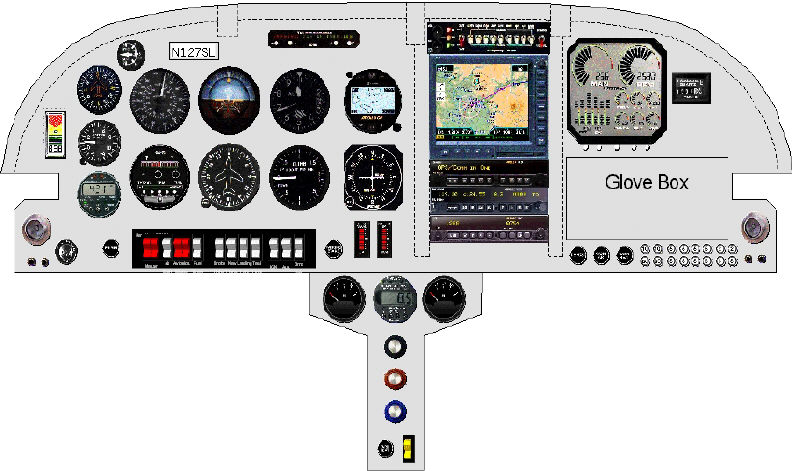
Option A features a full IFR panel with traditional flight instruments and "glass" engine monitoring and multi-function display computers. Estimated cost of this panel is $23,000.
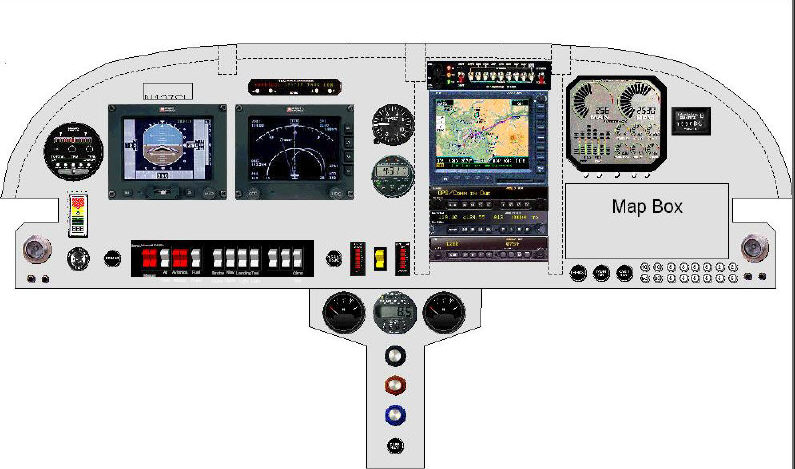
Option B is another IFR panel, but using "glass" for flight, navigation, and engine monitoring. This is the Meggit system. The two displays on the left are completely redundant. At the Meggit booth at Sun-n-Fun, they told me it would probably be available for about $53,000 for the system. I did manage to keep a straight face as I walked away. The total estimated cost of this panel is $80,500. So much for option B.

Option C is an IFR panel that features a different Primary Flight Display. I was just playing around with the Panel Builder online Java tool. Pretty Cool! This EFIS is from Sierra. The whole systems goes for about $58,000. I guess one would need to find room for another of their displays. But, at this price, I really don't consider it ready for what I think of as general aviation aircraft, much less my humble project. The estimated cost of this option is $85,500. Too bad, I'm kind of partial to the letter "C".
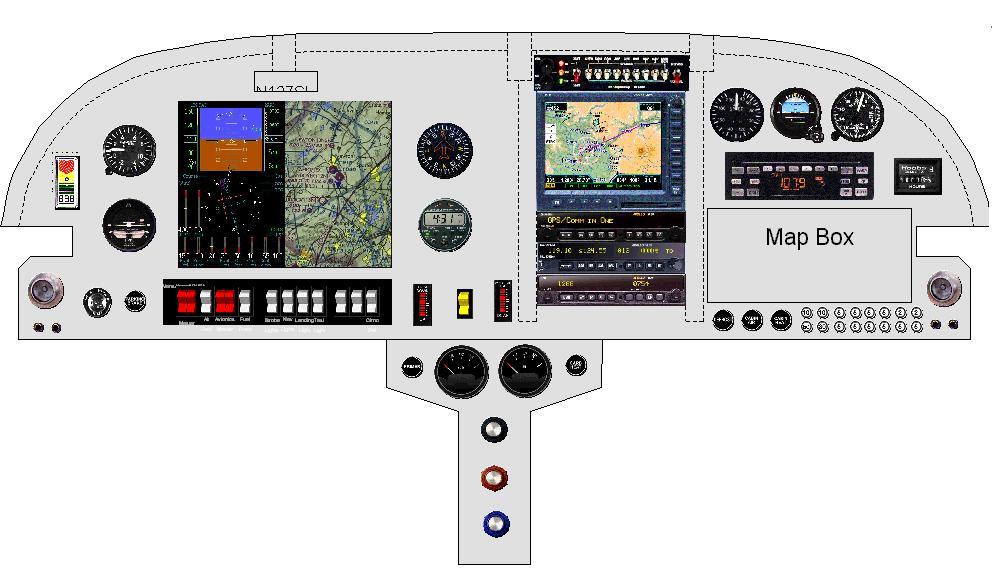
Now, here is an EFIS that might just be affordable. Its offered by Blue Mountain Avionics. I just saw an add for it in the June issue of the EAA's Sport Aviation magazine. The unit costs $8,800 with everything except engine sensors. The total value of this panel with redundant flight instruments, GPS, and the MFD is about $36,000. Not bad for all that stuff. Now, I just need to figure out what I can do with out.
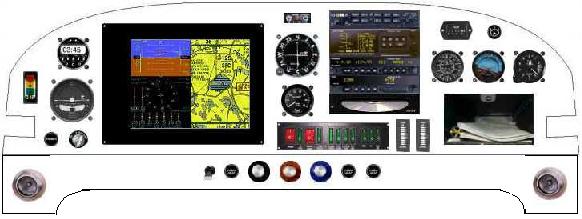
Another try at the EFIS One by Blue Mountain Avionics. After visiting their booth at Oshkosh this year (2002), I think this may just be my best option. Now that I have a better idea of what all it does, I removed the MFD. The price has gone up to $9,600 not including sensors. But, that includes software updates forever which is how new functionality is added. Eventually, data link and all the other things that the more expensive MFDs provide, should be available.
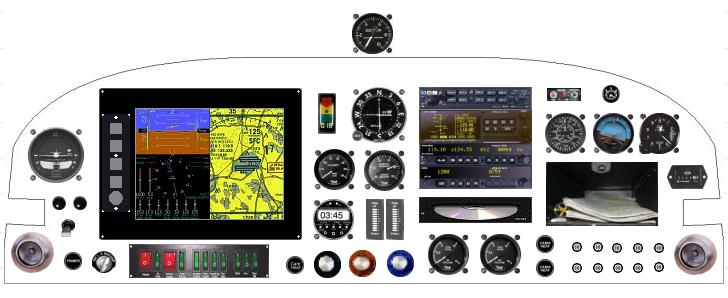
On this one, I'm trying to fit the fuel gauges, circuit breakers, and lighting knobs. Sure seems crowded.
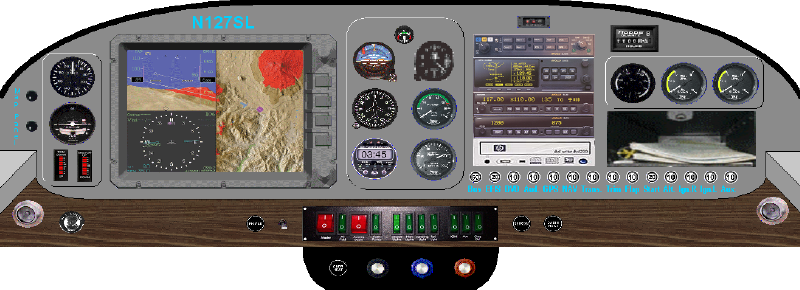
Taking Panel version F with a few layout modifications and trying to put some texture and color to it, I came up with Panel version G. This took quite a while to do using Microsoft PowerPoint® and the graphics files that come with Panel Planner®. I tried to imagine what it would be like to have to fly without the EFIS and think about where I would want the flight instruments. I also added the oil temperature and pressure gauge so that it will be legal to fly with the EFIS down. The labeling color is a simulation of a reverse engraved, back lit overlay. The wooden area would be a walnut overlay that could either be under the items on the panel or be cut to fit around them. For panel lighting, I thinking of using the strip lighting that goes under the glare shield overhang and the light rings for each of the round instruments. I'm still not sure where to put the map lighting that would shine down on my lap. I was thinking of using those mini-eyeball lights. They could either go on the panel since they are not needed to shine on the panel or go on the side wall of the cabin. At this point, I'm leaning towards putting them on the panel right next to the cabin air vents. The circuit breakers are a little over sized, but you get the idea. Everything else is pretty much to scale. If you have any ideas, comments, or suggestions, please email me here or the one on the home page. Oh, by the way, the EFIS_One goes up in price again on October 1st, 2002 to $12,800. Another Price update: now on September 21st, 2003 its almost $15,000!!!
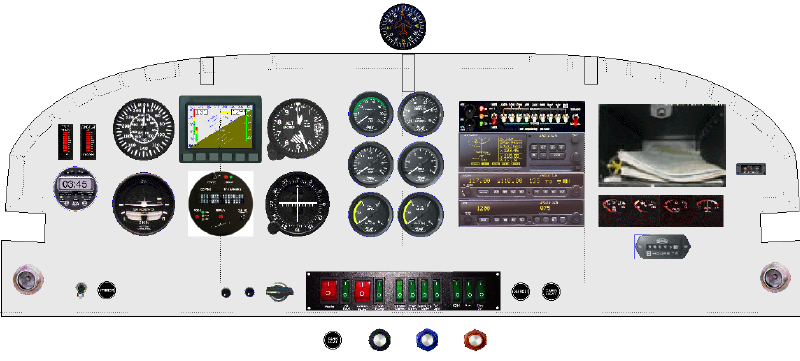
The rising cost of Blue Mountain Avionics EFIS_One and discussion threads on the RV List have me looking elsewhere for affordable "glass" instruments. Here is a configuration using the new Dynon Avionics EFIS-D10. Its a little light on engine instruments compared to full featured digital engine monitoring system. Maybe I can add that latter if funds permit. There are several other changes from the last version as well. This plan uses full size backup altitude and airspeed indicators. It removes panel mounted circuit breakers in favor of auto-style fuse blocks described in the AeroElectric Connection mounted on the sub panel. The Trio Avionics EZ Pilot auto pilot is placed under the EFIS-D10. The map box kit from Van's Aircraft is shown actual size and in its permanent location as it is now installed on the panel. And, under the map box are some of the Mitchell modular 1.5" gauges. I'm still planning on using the wood accent as in option G above. Also, I'd like to find a thin material I can use as an overlay to cover all the panel screws and soften the look and feel a bit. Cost of this panel option is about $20,000.
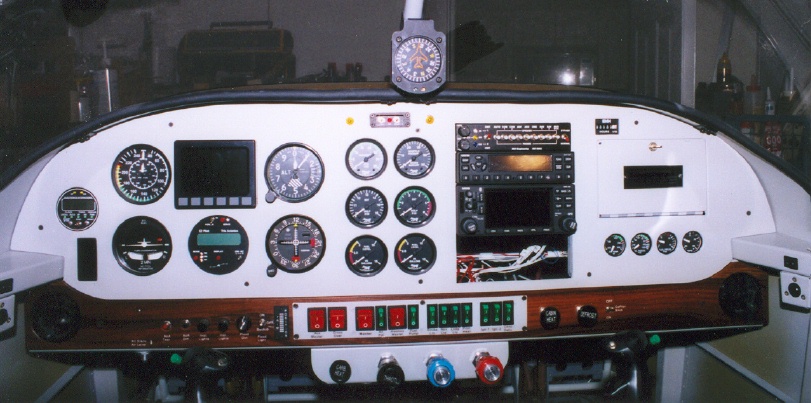
All done except for the XM-RADIO that will go at the bottom of the radio stack.
On the far left is an SC-5 Super Clock from Electronics International Inc. ®.
Below the clock is the Angle of Attach indicator from
Proprietary Software Systems, Inc..
Taking center stage in the flight instrument pack is the Electronic Flight Information System from Dynon Avionics,
the EFIS-D10. It is backed up on the left by an internally lit air speed indicator from
UMA Instruments Inc.
and on the right by an altimeter from
Pacific Coast Avionics.
To light the altimeter, I chose an electro luminescent bezel ring from UMA.
On the bottom row of flight instruments, in its familiar position, is an electric turn coordinator from
Falcon Gauge.
In the center bottom position is the EZ Pilot auto pilot from Trio Avionics.
Its servo is mounted in the right wing tip. In the spot you would normally see the vertical velocity
indicator is the GI-106A, VOR/LOC/GS/GPS course deviation indicator from
Garmin.
Mounted on the wind screen support bar is the PAI-700 vertical card magnetic compass from Precision Aviation, Inc.
Above the center engine instruments is the Emergency Locator Transmitter (ELT) indicator and test buttons.
The AK-450 ELT from Ameri-King Corp.
is located on the floor behind the pilots seat with the antenna mounted on the dorsal skin behind the sliding canopy.
The six engine instruments in the center stack from left to right and top to bottom
are the tachometer, manifold pressure, cylinder head temperature, exhaust gas temperature,
and left and right fuel gauges from
Van's Aircraft.
At the top of the radio stack is the RST-564-D Audio Panel from RST Engineering.
It is paired with the RST-523 remote mount marker beacon receiver. Under the audio panel is the Garmin
GTX-327 Transponder and the GNS-430 GSP/NAV/ILS/COM. Above the map box is the Hobbs meter.
The map box kit from Van's Aircraft is permanently
mounted. And, under the map box are some new 1.25" round engine instruments from
UMA Instruments Inc.
From left to right in this row are the oil temperature, oil pressure, fuel pressure, and ammeter. UMA silk screened the color limit markings
I gave them on these and the airspeed indicator.
I used Bolivian Rose wood with a natural teakwood oil finish for the accent overlay. I ordered an 1/8" short from
Rockler.
A thin aluminum overlay covers the top portion of the panel. It hides all the screws and gives it a finished look.
Along the bottom are all the switches and knobs. On the left side are the AoA test and dimmer buttons and the
instrument panel and flood light dimmer knobs. Next is the elevator trim position indicator.
In the center are the electrical switches. I modified the EXP-120 DC Load Center from
Control Vision
to replace the front panel and added two additional switches for the auxiliary and crossover contactors.
On the right are the control knobs for cabin heat and defrost. On the far right is a toggle switch I added to
deactivate the right seat control stick switches. Cost of this panel and supporting electical components is
approximately $22,000. Plan is to add a second GNS-430 once the money gods take pity on me. That would bring the total
to about $28,500.